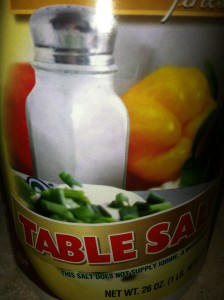Less Salt, Please
 Are you increasingly seeing more and more low-sodium products on the grocery shelves? This is because the 2010 Dietary Guidelines emphasize reducing salt in your diet to less than 2300 mg for otherwise healthy people and to less than 1500 mg for those who are 51 and older, African American or have hypertension, diabetes or chronic kidney disease.
Are you increasingly seeing more and more low-sodium products on the grocery shelves? This is because the 2010 Dietary Guidelines emphasize reducing salt in your diet to less than 2300 mg for otherwise healthy people and to less than 1500 mg for those who are 51 and older, African American or have hypertension, diabetes or chronic kidney disease.
Next week, March 10 – 16th, is National Salt Awareness Week, which was an initiative that began in 2008 by the World Action on Salt & Health (WASH) organization. WASH was established in 2005 with the mission of improving the world’s health by reducing sodium intake. WASH works to encourage multinational food corporations to reduce the amount of sodium added to their products. WASH also works with several governments of different countries around the world to encourage them to implement population-wide sodium reduction public initiatives.
The theme of this year’s Salt Awareness week is “Less Salt, Please!” In keeping with the 2010 Dietary Guidelines, the reduced salt theme emphasizes decreasing the sodium content of food prepared outside the home, such as in restaurants. The purpose of the theme is to encourage chefs, caterers, and the prepared food industry to reduce the amount of sodium added to food as well as to purchase lower-sodium ingredients and products. This theme, in large part, specifically targets the fact that prepared foods and processed meals typically contain high levels of sodium.
The Centers for Disease Control and Prevention currently estimate sodium intake of Americans at 3400 mg per day. This amount is significantly higher than the recommended amount. Reducing sodium intake is important for maintaining optimum health. There is strong evidence that links increased sodium intakes to high blood pressure, otherwise known as hypertension. Hypertension, in turn, can wreak havoc on your health by causing a plethora of chronic conditions, such as heart disease, diabetes, and chronic kidney disease. Other conditions or diseases linked to high sodium intakes include, stomach cancer, osteoporosis, and obesity.
So what can you do, as the individual, to lower your sodium intake? Ask restaurants for low sodium options or ask for the nutrition information of recipes. Read the nutrition facts label of foods you eat and keep a running tally of the amount of sodium you consume in a day. When shopping, it is best to avoid purchasing processed foods and choose items in which the label indicates low sodium. Eat a diet rich in fruits and vegetables and try to forgo high sodium dips, dressings and sauces.
Now it’s your turn to take action: What will you do this week to reduce your salt intake?


Leave a Reply
Want to join the discussion?Feel free to contribute!